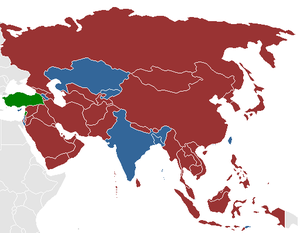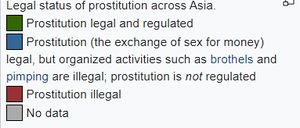Prostitution in India
We are still looking for more information on this article |
Prostitution in India is legal, but a number of related activities including soliciting, kerb crawling, owning or managing a brothel, prostitution in a hotel, child prostitution, pimping and pandering are illegal. There are, however, many brothels illegally operating in Indian cities, including Mumbai, Delhi, Kolkata, Pune, and Nagpur, among others. UNAIDS estimates there were 657,829 prostitutes in the country as of 2016. Other unofficial estimates have calculated India has roughly 3 million prostitutes. India is widely regarded as having one of the world's largest commercial sex industry. It has emerged as a global hub of sex tourism, attracting sex tourists from wealthy countries. The sex industry in India is a multi-billion dollar industry and one of the fastest growing.
History
A tawaif was a courtesan who catered to the nobility of India, particularly during the Mughal era. The tawaifs excelled in and contributed to music, dance (mujra), theatre, and the Urdu literary tradition and were considered an authority on etiquette. Tawaifs were largely a North Indian institution central to Mughal court culture from the 16th century onwards and became even more prominent with the weakening of Mughal rule in the mid-18th century. They contributed significantly to the continuation of traditional dance and music forms and then emergence of modern Indian cinema.
Goa was a colony in Portuguese India set up in the early 16th century, and this Portuguese stronghold contained a community of Portuguese slaves. During the late 16th and 17th centuries, the Portuguese trade in Japanese slaves resulted in traders from the Portuguese Empire and their captive lascar crew members from South Asia bringing Japanese slaves to Goa. These were usually young Japanese women and girls brought or captured from Japan as sexual slaves. Today, Goa is an Indian state.
The culture of the performing art of nautch, an alluring style of popular dance, rose to prominence during the later period of Mughal Empire and the rule of the British East India Company. During the period of Company rule (and after the Indian Rebellion of 1857, the direct administration of the British Crown), British colonial officials established and maintained brothels across the Indian subcontinent. The prostitutes who worked in such brothels were recruited from rural Indian families and paid directly by the British authorities. The red-light districts of cities such as Mumbai developed at this time. The governments of many Indian princely states had regulated prostitution in India prior to the 1860s. The British Raj enacted the Cantonment Act of 1864 to regulate prostitution in colonial India as a matter of accepting a necessary evil. The Cantonment Acts regulated and structured prostitution in the British military bases which provided for about twelve to fifteen Indian women kept in brothels called chaklas for each British regiment stationed in India. They were licensed by military officials and were allowed to consort with soldiers only.[29] In the 19th and early 20th centuries, thousands of women and girls from continental Europe and Japan were trafficked into British India, where they worked as prostitutes servicing British colonists and local Indian men.
"From time immemorial Indian poets have sung praises of the 'public woman', the professional entertainer. The epics give us a colorful description of her intimate connection with royal splendor. The Puranas highlight her auspicious presence as a symbol of good luck. Buddhist literature also testifies to the high esteem in which she was held in society. She appears through the ages in different incarnations from apsara in divine form to ganika, devdasi, nartika [ordinary dancer], kanchani, tawaif and the nautch girl."
– — Pran Nevile
Japanese prostitutes (the Karayuki-san) serviced British colonialists in British India where they were viewed as clean.
Operations and modus operandi
Prostitution in India manifests in various forms. The most notable instances where sex workers offer their services may include situations where these services are accessible under different disguises:
- Brothels: Buildings in which prostitutes are available.
- Streetwalkers/Street prostitution: Prostitutes who stand or walk in the streets, roads, highways or public spaces to get customers.
- Call girls: Prostitutes with whom an appointment can be made by telephone, usually to meet at the client's address.
- Escort agencies: An agency where people, especially young women, may be hired to accompany someone for entertainment, etc.
- Private residences: The place, especially the house, in which a person lives or resides.
- Massage & spa parlors: A place where people go and pay for a massage.
- Hotels: A commercial establishment offering lodging facilities.
- Nightclubs and bars: A place of entertainment open at night usually serving food and liquor and providing music and space for dancing and often having a floor show.
- Virtual sex, Cybersex and Phone sex services on online and on digital platforms: Online/phone-based sex-oriented conversations and exchanges through audio, images, video or texts.
- Devdasi, temple dancers devoted to the practice of spiritual dancing but are forced into sex work.
Organization
Government organizations like MDACS (Maharashtra District AIDS Control Society) have played a very prominent role in generating awareness of HIV/AIDS through assistance in providing free literature and organizing street campaigns. There are several NGOs that work to prevent the spread of STI/STDs in the community. NACO (National AIDS Control Organisation), a government agency, leads these NGOs. The Durbar Mahila Sumanwua Committee is a sex-workers' union based in Sonagachi, Kolkata, which has 65,000 members. They advocate for labor rights for sex workers, and they also fight against trafficking.
Prevalence
There were an estimated two million female sex workers in the country in 1997. In 2007, the Ministry of Women and Child Development reported the presence of over 3 million female sex workers in India, with 35.47 percent of them entering the trade before the age of 18 years. The number of prostitutes rose by 50% between 1997 and 2004.
Underage prostitution
- Wikipedia article: Child trafficking in India
Surveys show there are an estimated 1.2 million children involved in prostitution.
Research
Much new knowledge on sex work in India came from the first major survey, in April 2011. This was performed by the Centre for Advocacy on Stigma and Marginalisation (CASAM), which is part of SANGRAM, a major NGO that deals with sex workers.
Red-light districts of India
- Sonagachi ↗, Kolkata ↗: Asia's largest red-light district with over 11,000 sex workers.
- Kamathipura ↗, Mumbai: Second largest red-light district in India with approximately 5,000 sex workers.
- Budhwar Peth ↗, Pune: India's third largest red-light district with home to around 5,000 sex workers and 700 brothels.
- Chaturbhuj Sthan ↗, Muzaffarpur: A red-light district in Bihar with around 3,500 sex workers.
- Shivdaspur ↗, Uttar Pradesh: A town in Varanasi district with a red-light district housing approximately 2,000 sex workers.
- G. B. Road ↗, New Delhi: A red-light district in the Indian capital with many brothels and over 1,000 sex workers.
- Ganga Jamuna ↗, Nagpur: A red-light district with as many as 188 brothels[63] and thousands of sex workers.
- Reshampura ↗, Gwalior: A red-light district in Madhya Pradesh.
- Kabari Bazar ↗, Meerut: A red-light district with hundreds of sex workers operating from around 75 brothels.
- Meergunj ↗, Prayagraj: A red-light district with a significant number of sex workers infamous for illicit trafficking and forced prostitution.
The operation of brothels is officially prohibited (de jure), yet in practice, these establishments are confined to specific areas within urban locales. Despite the lack of official sanction for brothels, minimal efforts are exerted to eradicate or impede its existence. The living conditions within these establishments are notably substandard, marked by dilapidated infrastructure, insufficient lighting, malodorous environments, uncleanliness, and an overall lack of sanitation. Notably, the prevalence of sexually transmitted diseases, including HIV/AIDS, is exceptionally high in these establishments and the services provided within these brothels are usually available at a notably cheap price. The environment in the brothels, particularly in the surrounding alleys, is deemed hazardous, especially during the night, with reports of various other forms of criminal activities.
References
External links
- Wikipedia article: Prostitution in India
- US State Department Annual Human Rights Reports about India
- Rape For Profit — Human Rights Watch Report
- Navjeevan Mumbai Sex work outreach
- The Immoral Traffic (Prevention) Act 1956
- Legalise prostitution in India to address problems of sex industry Article by K Rajasekharan
Chat rooms • What links here • Copyright info • Contact information • Category:Root

